Federal Glass Company
“F within a shield” trademark
Columbus, Ohio
The “F inside a shield” logo was first used by Federal Glass Company in 1932, according to the U.S. Patent & Trademark Office records, but as researcher/ author Marg Iwen reported in her article on Federal, the mark is shown in catalogs as early as 1927. How late this mark was used seems open to question, as some research sources seem to imply the mark was phased out around 1958, which was when Federal Glass merged with Federal Paper Board Company, Inc. (based in Montvale, New Jersey). The merger took place in June of that year.
However, judging from empirical evidence, it seems more likely the “F in a shield” was used all the way up to 1979 when the factory closed down production. Some glass items made for the United States Bicentennial (1976) are marked with the “Shield F”.
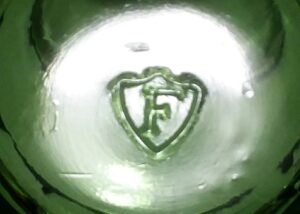
This company began as one of the first important glass manufacturers to use automated machinery, producing large quantities of beverage tumblers and fruit jars in the very early 1900s.
For more detailed background on the formation and early history of Federal Glass Company, their company officials, etc., please see this PDF file article by glass researcher Bill Lockhart et al: https://sha.org/bottle/pdffiles/FederalGlass.pdf
Federal Glass Company was the manufacturer of a TREMENDOUS variety of tableware, including tumblers, stemware, shot glasses, plates, bowls, punchbowl sets, mugs, packer jars, toothpick holders, ashtrays, storage canisters, etc. The firm produced a lot of “institutional” glassware for the restaurant, bar and hotel trades.
This company is especially well known and celebrated for it’s highly collectible lines of Depression Glass tableware so popular during the 1930s and 1940s. Much of their Depression glass was not marked.
Here are some of the glass tableware patterns that were made by Federal Glass Company during the Great Depression Era: Colonial Fluted, Columbia, Diana, Georgian (Lovebirds), Mayfair, Normandie (Bouquet and Lattice), Patrician (Spoke), Raindrops (Optic Design), Rosemary (Dutch Rose) and Sharon (Cabbage Rose). Photos and descriptions of these patterns can be found in the “Collector’s Encyclopedia of Depression Glass” series of books written by Gene and Cathy Florence.
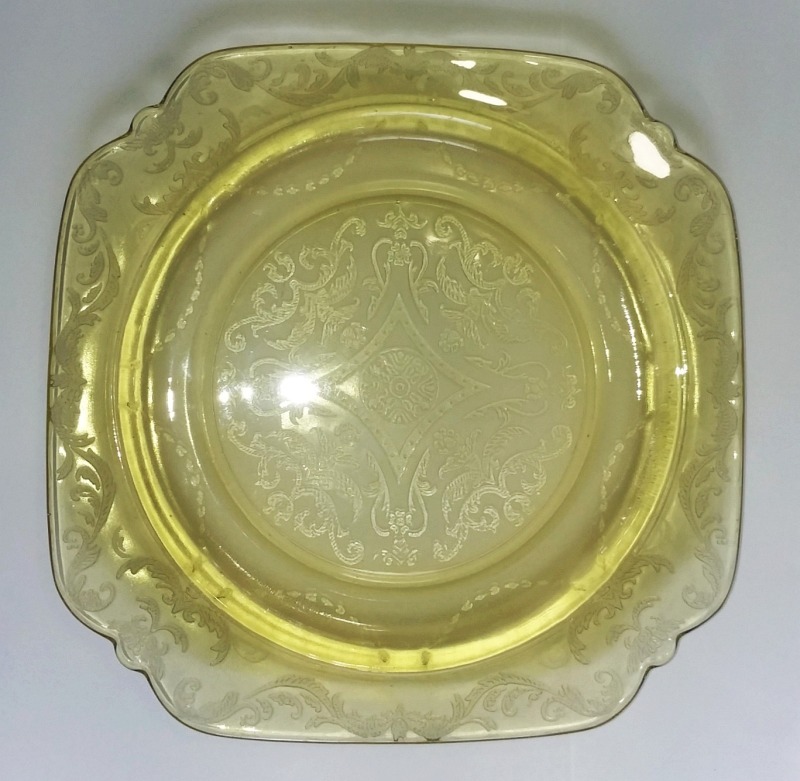
Their most well-known pattern produced during the depression years would probably be their MADRID pattern (dinner plate shown above), most often seen in a light yellowish amber (sold under the name “Golden Glow”). In 1976, Federal reissued pieces in the Madrid pattern (calling it “Recollection” in their glass catalog) and added the date “1976” to the molds so those pieces are easily distinguishable from the older glass.
However, after Federal closed down, some of the Madrid molds were sold to Indiana Glass Company, the “1976” was removed from the molds, with more glass being produced (in several colors including a paler pink, harsher blue shade, and teal) which has led to considerable confusion for collectors!! Here is a link to a very informative article on the Madrid pattern, posted by the National Depression Glass Association: http://www.ndga.net/nandv/00nv05a.php
Here is an article about differences between the older Madrid pattern and the newer “Recollection” pieces made by Federal:
Madrid Pattern: Old Versus New
ADVERTISEMENT
Another very popular and much-loved pattern made by Federal is their Cabbage Rose or Sharon pattern. (Sharon was the original factory name for the pattern). Here is a page that discusses that pattern with photos, and gives information concerning some reproductions made in the 1970s:
Federal Glass’s SHARON / CABBAGE ROSE pattern
Federal Glass Company “SHOW OFF JARS” / KITCHEN storage canisterS / COOKIE JARS (1972-1979)
These jars are quite common and have been very popular for half a century, and are often seen for sale in antique malls, thrift stores and on online sites such as ebay and etsy. They are also one of the most misattributed glass items that the collector will come across in their quest for colorful vintage glass! They are NOT marked on the bottom which has certainly added to the confusion!
These jars were shown for sale in Federal’s wholesale catalogs from 1972 to 1979. (Although, technically the 1979 catalog was published early in 1978). The jars were manufactured in yellow amber (called “Sun Gold”), clear (“Crystal”), lime green, teal blue (rich blue aquamarine), iridescent smoke (“Sundown”) carnival glass, as well as three “surface flashed” or “applied” opaque colors: red, yellow, and a rather light pastel green. Amber is probably the most common color. (Those catalogs were sent primarily to shopkeepers, department and variety store managers and other retailers, and so were not so often seen by the average consumer).
These jars are often loosely called cookie jars, display jars, kitchen canisters, apothecary jars or counter jars and are often wrongly attributed to L. E. Smith Glass Company, Imperial Glass Company and/or Indiana Glass Company, all of which are incorrect.

The pattern is often popularly called “Atterbury Scroll” which isn’t really correct either. Exactly why they are known as “Atterbury Scroll” is somewhat unclear, but probably because the pattern is similar in appearance to a pattern produced by Imperial Glass Company, Bellaire, Ohio (1901-1984), known as “Scroll” (Imperial’s No. 320). Also, a much older “scroll type” pattern was made in the late 1800s by Challinor, Taylor & Company, Tarentum, PA (1884-1891) which was catalogued as their “No. 314” pattern. However, Challinor never made any type of item that remotely resembles these modern canisters. Atterbury & Company, Pittsburgh, PA (1860-c.1902) was a close competitor of Challinor and produced similar opaque wares – so some early “Scroll” pattern pieces by Challinor might have been mistakenly attributed to Atterbury.
L.E. Smith Glass Company (Jeannette, PA, 1907-2007) made canisters (in a variety of colors) in their “Moon and Star” pattern (a revival of a pattern originally called “PALACE” in the EAPG era). Those storage canisters look quite similar in appearance to the “Show Off” jars made by Federal, which may explain some of the confusion.
Large numbers of these “Show Off” jars listed on ebay are attributed to the wrong glass company! Unfortunately, many online sellers, when listing an item, have no idea what they have, so they just do a quick search – and copy what other sellers are putting in their descriptions for similar items. So, the cycle of misinformation is repeated ad nauseum.

TOY MUG or “HANDLED WHISKY” SHOT GLASS
One of the most commonly seen items made by Federal Glass is their “miniature beer mug”, toy mug, toothpick holder or “whisky” shot glass, as shown below. This piece typically measures about 2 inches in height, and the base measures one and 1/2 inches in diameter. They were usually sold and listed as “Toy mugs” in earlier glass factory catalogs. In modern times they are often described or listed as shot glasses or toothpick holders, and are collected by those searching for both of those types of glass items.
This style of mug was evidently made over a very long period of time, and is seen in several colors. The most common color (if I can use that term in this instance) is clear. Other colors seen include teal blue or teal aqua, several slightly different shades of amber, pink, light amethyst with a pinkish cast, yellow, olive or avocado green, and a medium emerald green which seems to be rather scarce.
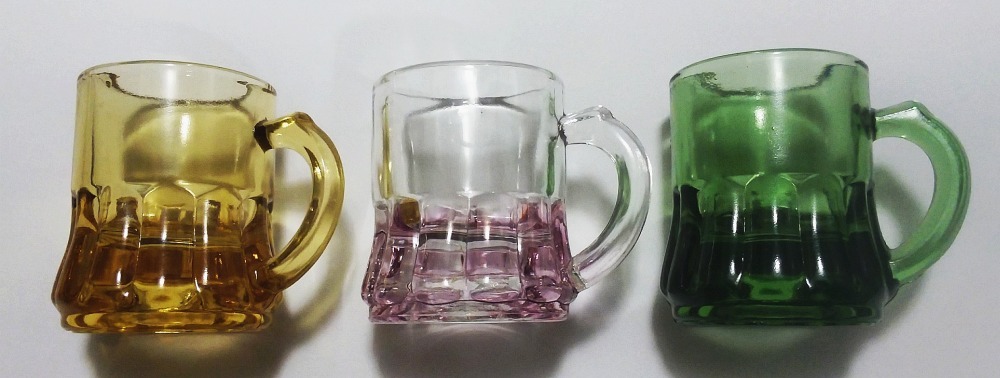
Many of these “mini mugs” described above are marked on the bottom with the “F inside a shield” trademark. Some, however, are not marked. The versions with the mark on the base may date later in Federal’s production, perhaps 1940s-1970s (?) . They are shown in some catalogs as a one ounce “handled whisky” (shot glass).
The oldest versions of this same style of “toy mug” (which was made by a number of glass companies including Federal) date back to the EAPG era, are typically seen in ruby stain over clear glass, and occasionally in a light yellowish-beige opaque glass usually called “custard”.
The ruby stained examples were commonly engraved or etched with names, dates or other information, originally presented as souvenir pieces and given as gifts or to commemorate some special occasion, celebration or event. Many were engraved as souvenirs of fairs, expositions and tourist attractions. The most common dates seem to be from the 1900s-1910s period, but some date into the 1920s or later, which shows that they were very popular as a souvenir item for a long period of time.
In the reference book “Pattern Glass Mugs” by John B. Mordock and Walter L. Adams (1995), mugs of this general type are shown on page 97 and 98, described as a “Penny Candy” mug. They list a version made by Westmoreland Specialty Company c. 1905, (they call it “Oriental penny candy”), said to be found in custard, opaque green, opaque blue, and ruby stain. They also show a version (called “Penny Candy”) stated to have been made by Federal as early as 1914 (from a catalog listing), made in amber, cobalt blue, souvenired ruby stain, and “possibly in other colors”.
Apparently some of these miniature mugs were used in bygone days as small “scoops” to measure out penny candy from the large glass counter jars (display jars) in general dry goods stores, confectionaries, drugstores, etc.
In trying to find out more information on these mugs, I found that there were actually at least TEN or more different glass companies that made similar mugs, identical or almost identical to the ones confirmed to be of Federal Glass manufacture. The earliest examples I’ve seen in online sales listings date as far back as 1895 (there are probably older ones as well). Since they are all very similar, with no markings on the bottom to indicate the glass manufacturer, it is now difficult, if not impossible, to be sure which glassmaker actually made any particular one of the older mugs of this type. Although Federal assumedly did make many of the souvenired versions with red stain over clear glass, any specimen encountered could presumably be a product of some other glass company. Here is a page from the Early American Pattern Glass Society website which shows several catalog cuts from various glass companies:
https://www.eapgs.net/full-images.php?idx=82373&pat=6135
Other Glass Companies besides Federal that made these Toy Mugs
Thanks to information gathered by collector and researcher Sid Lethbridge, we know that similar mugs were also made by the following glass companies (in addition to Federal), and other unidentified companies probably made them as well: Westmoreland Specialty Company, Grapeville, PA (1889-1924); Cambridge Glass Company, Cambridge, OH (1902-1958); Cooperative Flint Glass Company, Beaver Falls, PA (1879-1930s); Heisey Glass Company, Newark, OH (1895-1957); Jefferson Glass Company, Steubenville, OH & Follansbee, WV (1900-1930); McKee Glass Company, Jeannette, PA (1904-1954); Monongah Glass Company, Fairmont, WV (1903-1928); Paden City Glass Company, Paden City, WV (1916-1951), and U.S. Glass Company, Pittsburgh, PA (1891-1962).
“INNOVATION” pattern ashtrays made by Federal Glass Company
These sturdy ashtrays are frequently (and incorrectly) attributed to Blenko Glass Company. They appeared in Federal Glass catalogs from 1969 to 1979. They were made in three sizes: 4 inches , 6 inches, and 8 inches in diameter, and are unmarked on the base. The surface of the glass has a “pebbled” uneven texture. They were produced in clear glass (“Crystal”), iridescent clear, lime green (“Limelight”), amber (“Sun Gold”) and a strong teal blue/aquamarine (as shown on a 1975 catalog page). The 1979 catalog only lists these in clear and amber glass.
Ashtrays that appear to be identical were also made by Libbey Glass Company, although the Libbey examples may have a smooth surface on all sides with no pebbling. Some of the Libbey examples have been found with personalized company advertising on the bottom.
The Federal Glass molds were eventually sold to Indiana Glass Company (1980), and ashtrays of this type were shown in some Indiana Glass catalogs of the mid-1980s. It is unclear if Indiana made any examples of this style in any colors other than clear.
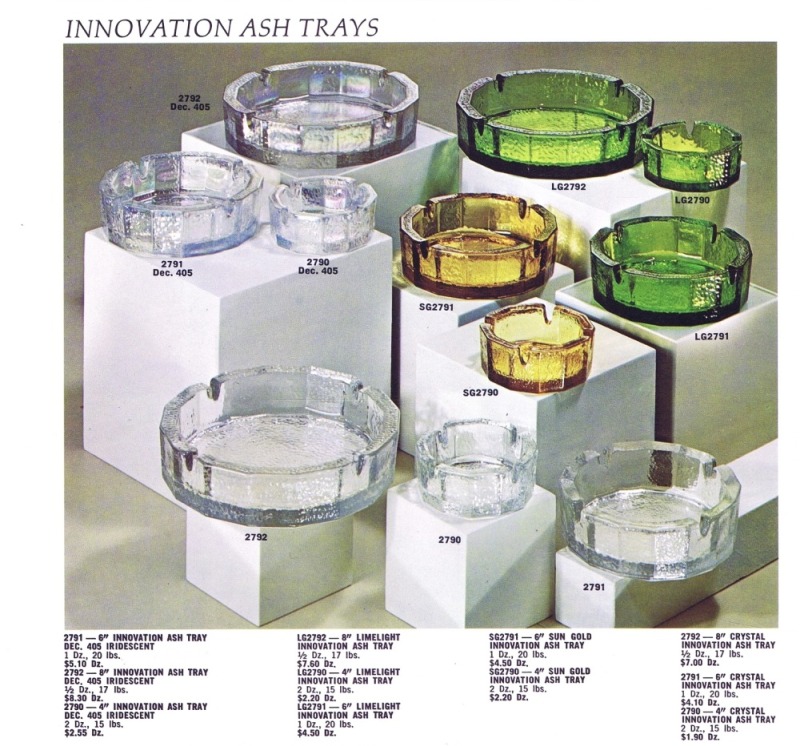
FEDERAL GLASS COMPANY ~ FACTORY LOCATION
The Federal Glass Company factory grounds were located on the south side of Columbus, in the area bounded by Woodrow Avenue on the north, Ann Street and Wager Street to the west, and Marion Road on the south. A road named “Federal Parkway” now cuts through part of the area where the factory was situated. This part of Columbus is still primarily an industrial area, with a variety of newer businesses now located in the general vicinity.
A very detailed article about Federal Glass Company, it’s formation, company predecessors and it’s end can be found here: https://www.fohbc.org/PDF_Files/ShieldF_MIwen.pdf

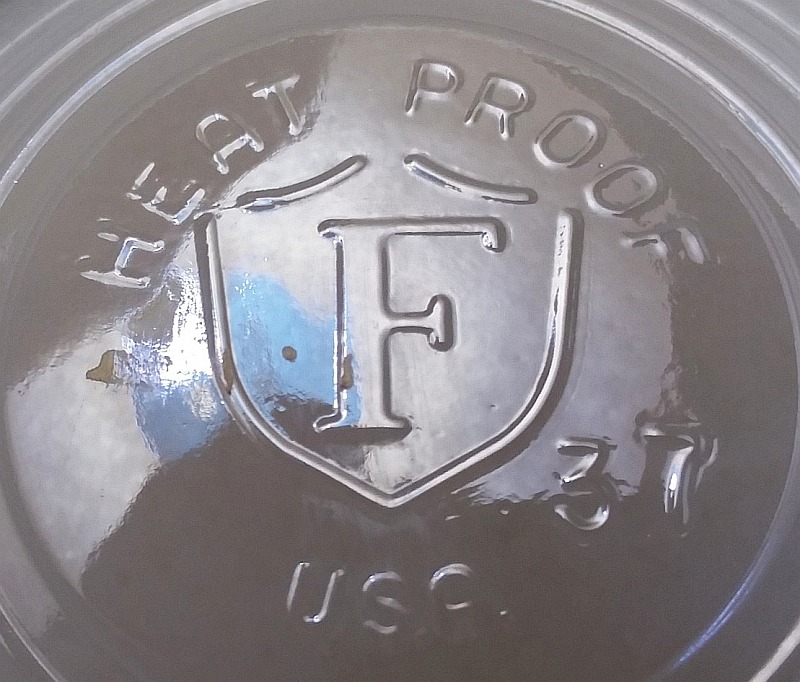
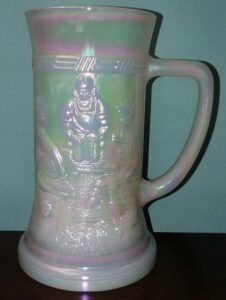
Please click here to go to my Home Page.
For an extensive list of glass manufacturers’ marks on bottles, fruit jars, insulators, tableware and other glass items, please check out the GLASS BOTTLE MARKS pages, here beginning with PAGE ONE.
What is Uranium Glass? (Vaseline Glass, Depression Glass, Burmese Glass, etc.).
What is Sea Glass / Beach Glass?
What is EAPG (Early American Pattern Glass)?
ADVERTISEMENT

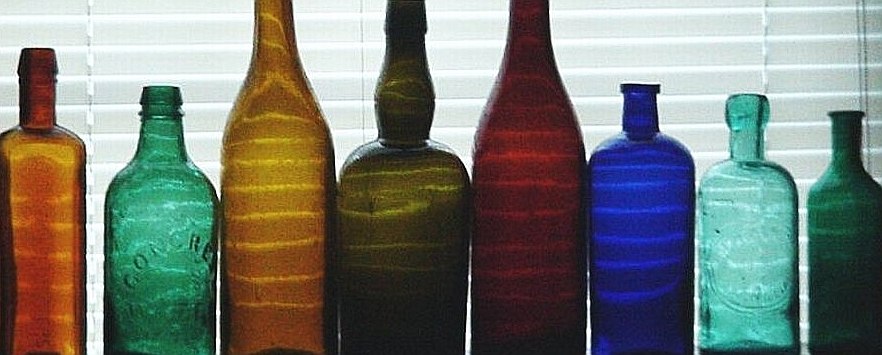
I have a 1937 Philco radiobar, I am trying to purchase replacement glass for the unit. Where can I get info on this? It’s 3 ring platinum and different sizes.